Minoxidil, a common treatment for hair loss in humans, can pose significant health risks to our pets. This comprehensive guide explores the dangers of minoxidil exposure to cats and dogs, symptoms of toxicity, and critical steps to keep your furry friends safe.
Is Minoxidil Harmful to Pets? What Owners Should Know
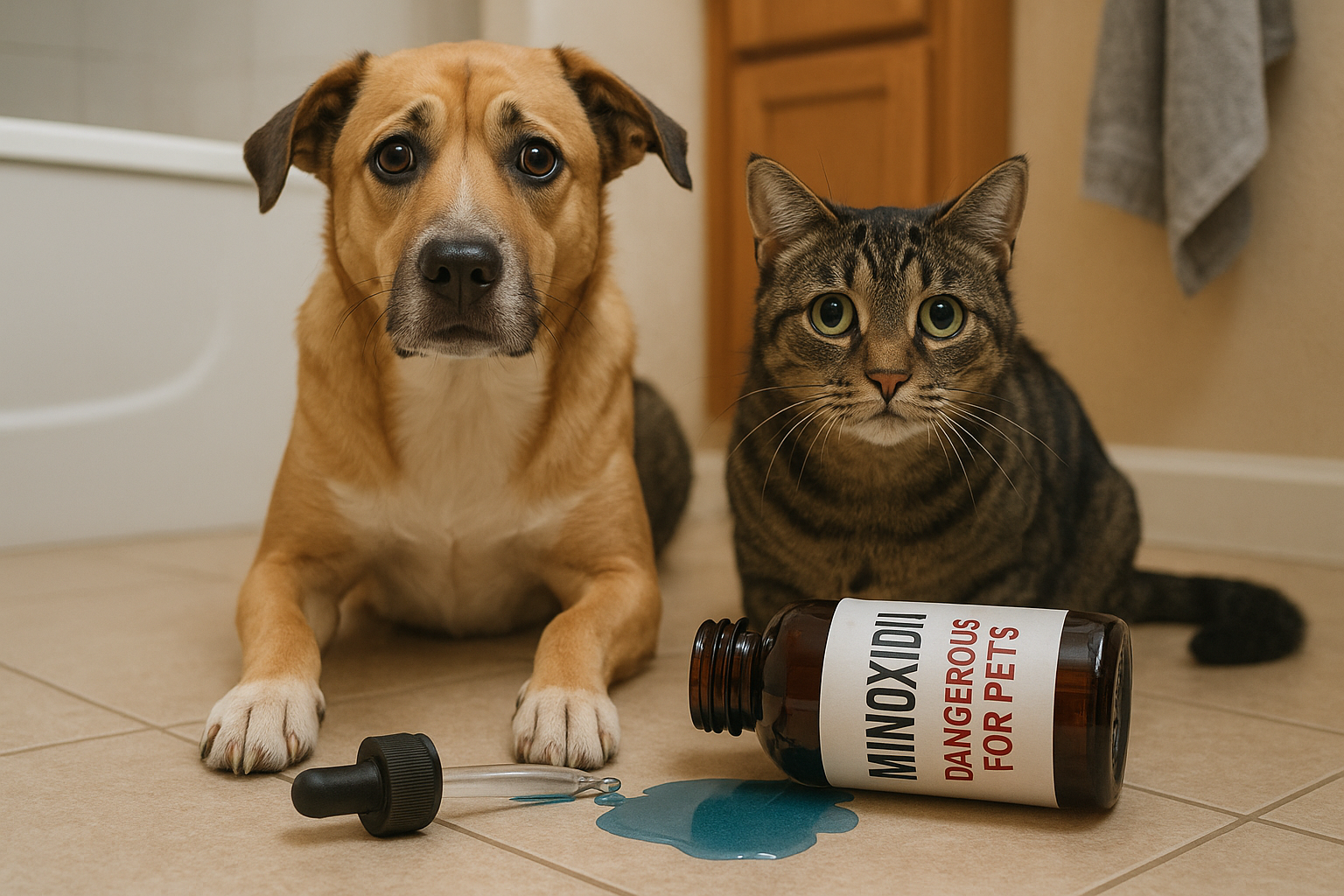
A worried dog and cat sit close together on the bathroom floor beside a spilled medicine bottle.
Yes, minoxidil is extremely harmful to pets. This common hair loss treatment can be fatal even in small amounts if ingested or absorbed through a pet’s skin. Minoxidil toxicity in cats and dogs typically manifests within hours of exposure, causing severe cardiovascular effects including rapid heart rate, hypotension, and potential heart failure.
Many pet owners applied minoxidil without realizing the danger until their companion showed symptoms of minoxidil poisoning. The substance is particularly toxic to cats, who may be exposed by walking across surfaces where the product has dripped or by grooming an owner who recently applied the treatment.
Veterinary experts emphasize that there is no safe level of minoxidil exposure for pets. Even trace amounts can trigger serious reactions requiring emergency treatment. Understanding these risks is essential before bringing minoxidil-containing products into homes with animals.
Let’s explore exactly how minoxidil works and why its mechanism makes it so dangerous to our four-legged companions.
Minoxidil: What to Know About This Hair Loss Treatment

A worried pet owner notices their curious cat and dog near a spilled bottle, highlighting the importance of keeping pets safe at home.
Minoxidil began as a blood pressure medication before researchers discovered its hair-growth properties. Today, it’s available over-the-counter in products like Rogaine in concentrations of 2-5%, making it accessible to millions seeking hair loss solutions. The medication works by dilating blood vessels and extending the growth phase of hair follicles.
While beneficial for humans, this vasodilation mechanism is precisely why minoxidil is extremely toxic to pets. When cats or dogs are exposed, minoxidil rapidly enters their bloodstream, causing dangerous drops in blood pressure and potentially fatal heart problems. Cases of minoxidil toxicosis in pets have increased as more pet owners applied minoxidil without understanding the risks.
The danger extends beyond direct application. Pets can be exposed by walking on treated surfaces or through contact with their owner’s skin after application. Even the foam formulations marketed as “quick-drying” pose significant risks. Understanding these mechanisms helps explain why minoxidil toxicity requires immediate veterinary intervention.
Minoxidil Toxicity in Pets: Understanding the Dangers
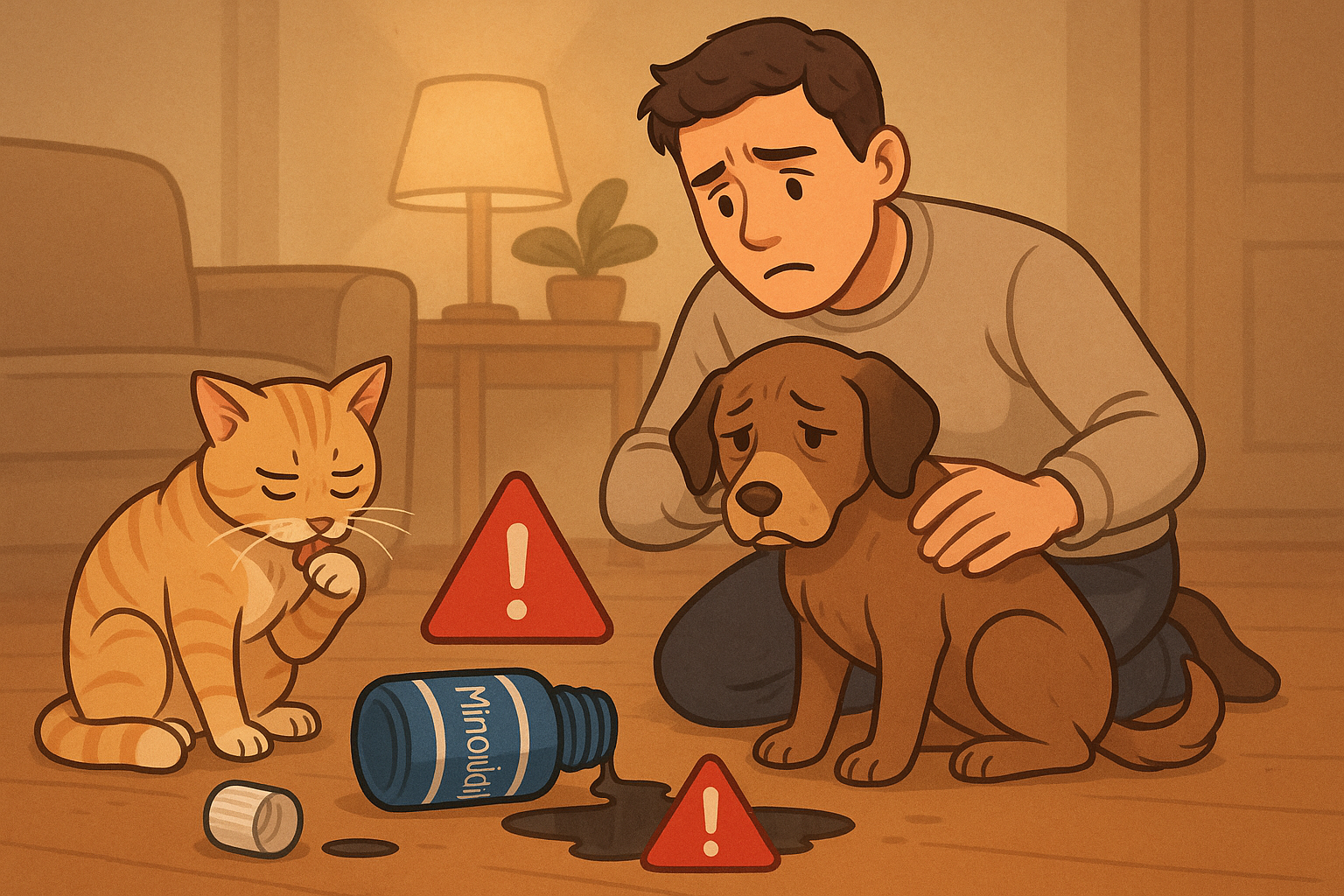
A concerned pet owner comforts their tired cat and dog after a spilled bottle of medicine.
When minoxidil enters a pet’s system, the effects can be devastating. Is minoxidil harmful to pets? Absolutely—it’s extremely toxic, with as little as 0.1ml/kg body weight capable of causing severe symptoms. The compound rapidly absorbs through skin and mucous membranes, triggering dangerous cardiovascular effects within hours of exposure.
Initial signs of minoxidil toxicosis include lethargy, vomiting, and tachycardia (rapid heart rate). As toxicity progresses, pets may develop hypotension (low blood pressure), respiratory distress, and pulmonary edema. Without intervention, cardiac failure and death can follow. Cats are particularly vulnerable due to their smaller size and grooming habits.
Many cases occur when pet owners applied minoxidil without realizing the danger, or when pets contacted treated surfaces. The insidious nature of minoxidil toxicity lies in its delayed symptoms—pets may appear normal for hours before suddenly deteriorating. By understanding these dangers, we can better grasp the importance of proper minoxidil handling and storage to protect our animal companions.
Cats and Dogs: Different Reactions to Minoxidil Exposure
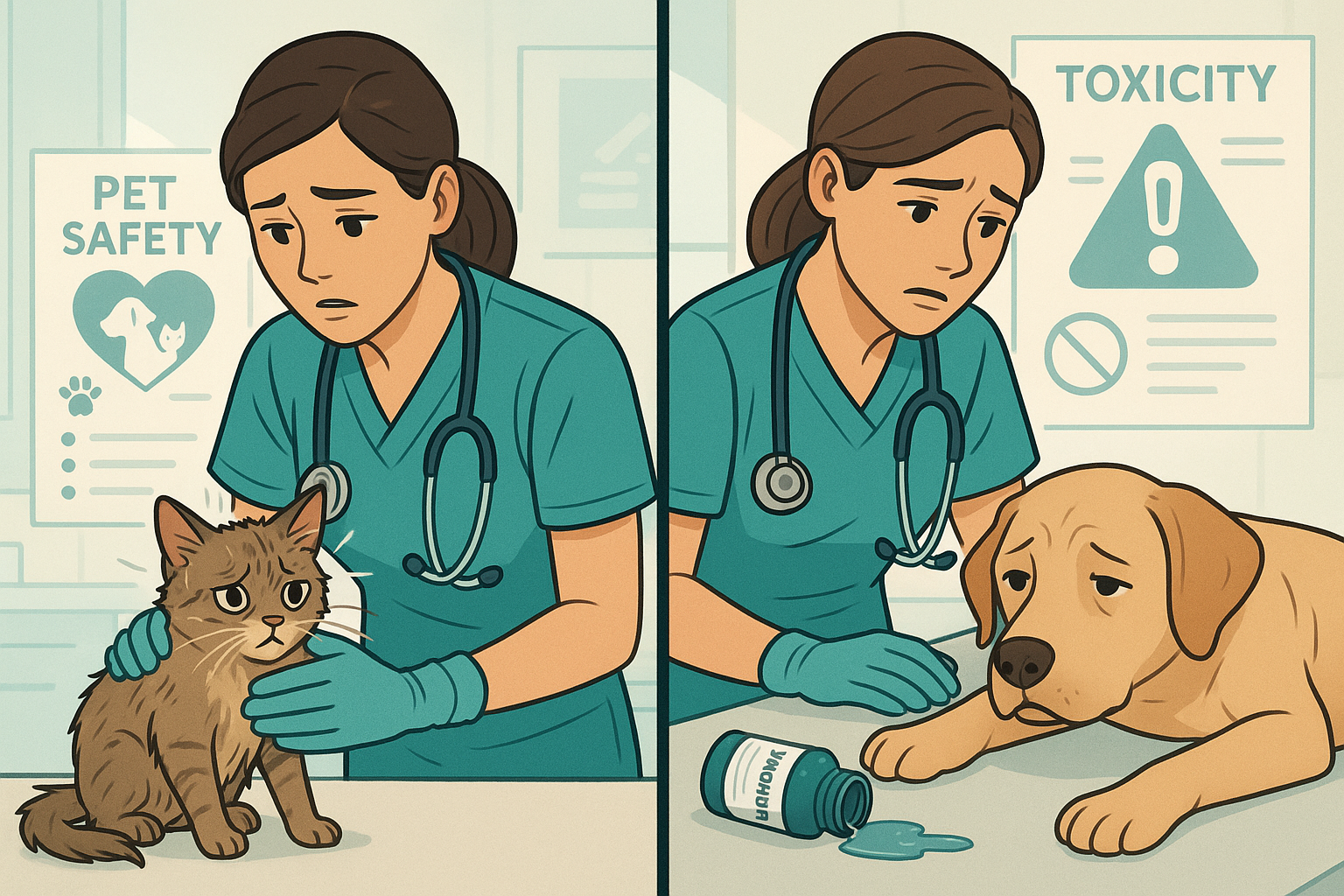
A caring veterinary team gently comforts a worried cat and a tired dog during a busy day at the clinic.
While minoxidil toxicosis affects both cats and dogs, their reactions differ significantly. Cats face heightened vulnerability due to their smaller body mass and meticulous grooming habits, which increases ingestion risk when minoxidil contacts their fur. Their unique liver metabolism also struggles to process the compound efficiently, accelerating toxicity onset.
Dogs typically encounter minoxidil when pet owners applied minoxidil products carelessly or left containers accessible. Their larger size provides some buffer against small exposures, but curious chewing behaviors can lead to concentrated ingestion from product tubes. In dogs, minoxidil poisoning often manifests first as vomiting and lethargy, while cats may show immediate respiratory distress.
Both species develop cardiovascular complications, though cats typically deteriorate faster. Understanding these species-specific vulnerabilities helps veterinarians tailor treatment approaches when minoxidil toxicity occurs in our beloved companions.
Prevention Tips to Keep Your Furry Friends Safe
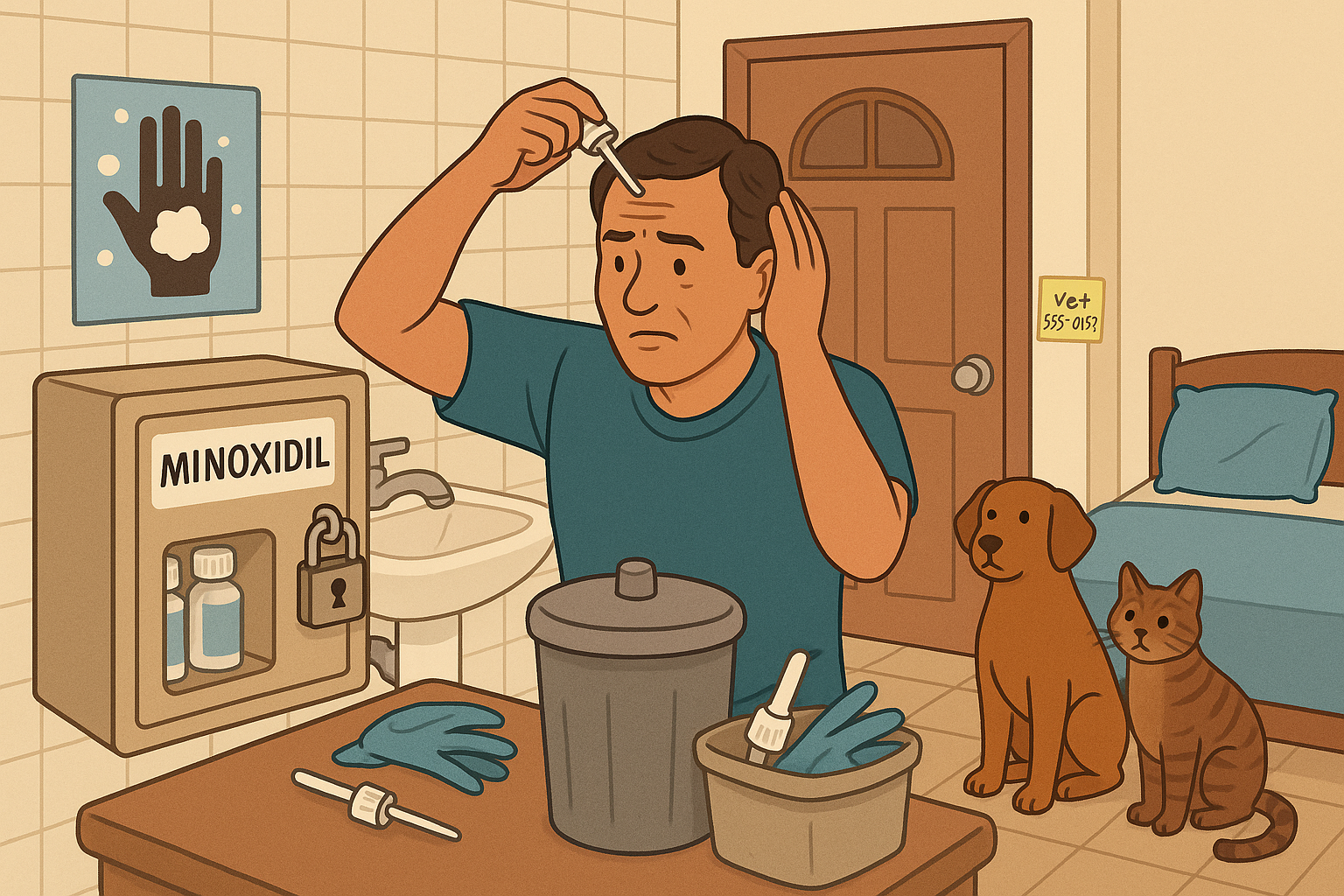
A pet owner carefully washes up while their curious cat and dog wait patiently in the hallway, creating a warm scene of everyday care and safety.
Since minoxidil is extremely toxic to pets, prevention is absolutely crucial. Always store minoxidil products in locked cabinets or drawers completely inaccessible to curious paws and noses. When you apply minoxidil, do so in a separate room with the door closed, keeping pets away until the product has completely dried on your scalp or skin.
After application, thoroughly wash your hands before touching your pets. Discard application materials (droppers, gloves) in sealed containers pets cannot access. Never allow pets to lick or nuzzle your head after application, and consider covering pillowcases if you apply minoxidil before bedtime and share sleeping space with pets.
If accidental exposure occurs, immediately wash any product from your pet’s fur with mild soap and contact your veterinarian – keep their emergency number readily available. The faster you respond to potential minoxidil toxicity, the better your pet’s chances of recovery. Understanding exactly how minoxidil affects different pets helps emphasize why these precautions are so vital to their safety.
Minoxidil Toxicity: Dangerous Levels and Who’s at Risk
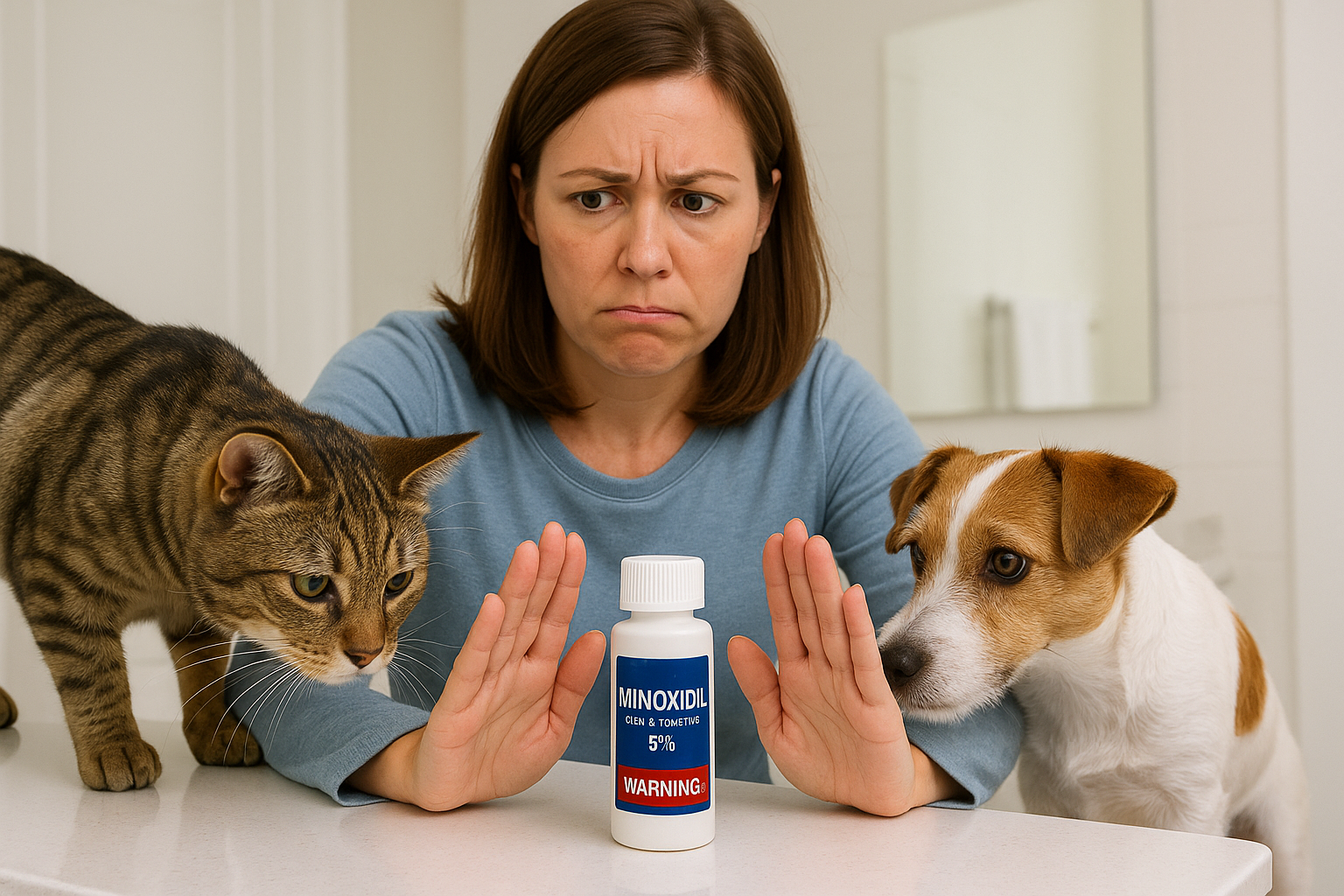
A caring pet owner keeps a watchful eye as their curious cat and dog approach a medicine bottle on the bathroom counter.
The question “is minoxidil harmful to pets” has a clear answer: extremely. For cats, ingesting just 0.2ml of 5% minoxidil solution (a single drop) can trigger severe minoxidil toxicosis. Dogs face similar risks, with toxicity proportional to their weight – smaller breeds requiring emergency care after minimal exposure.
Pets at highest risk include curious kittens and puppies who investigate everything with their mouths, animals with pre-existing cardiovascular conditions, and smaller pets with less body mass to dilute the toxin. The concentration matters significantly – 5% solutions are more dangerous than 2% formulations, while foam products may be slightly less immediately accessible but equally toxic if ingested.
When pet owners applied minoxidil without proper precautions, cases of secondary exposure have occurred through pets licking treated scalps or sleeping on contaminated pillowcases. Understanding these specific risks helps emphasize why meticulous handling of minoxidil products is essential for protecting your pets’ lives.
Safely Applying Minoxidil When You Have Pets at Home
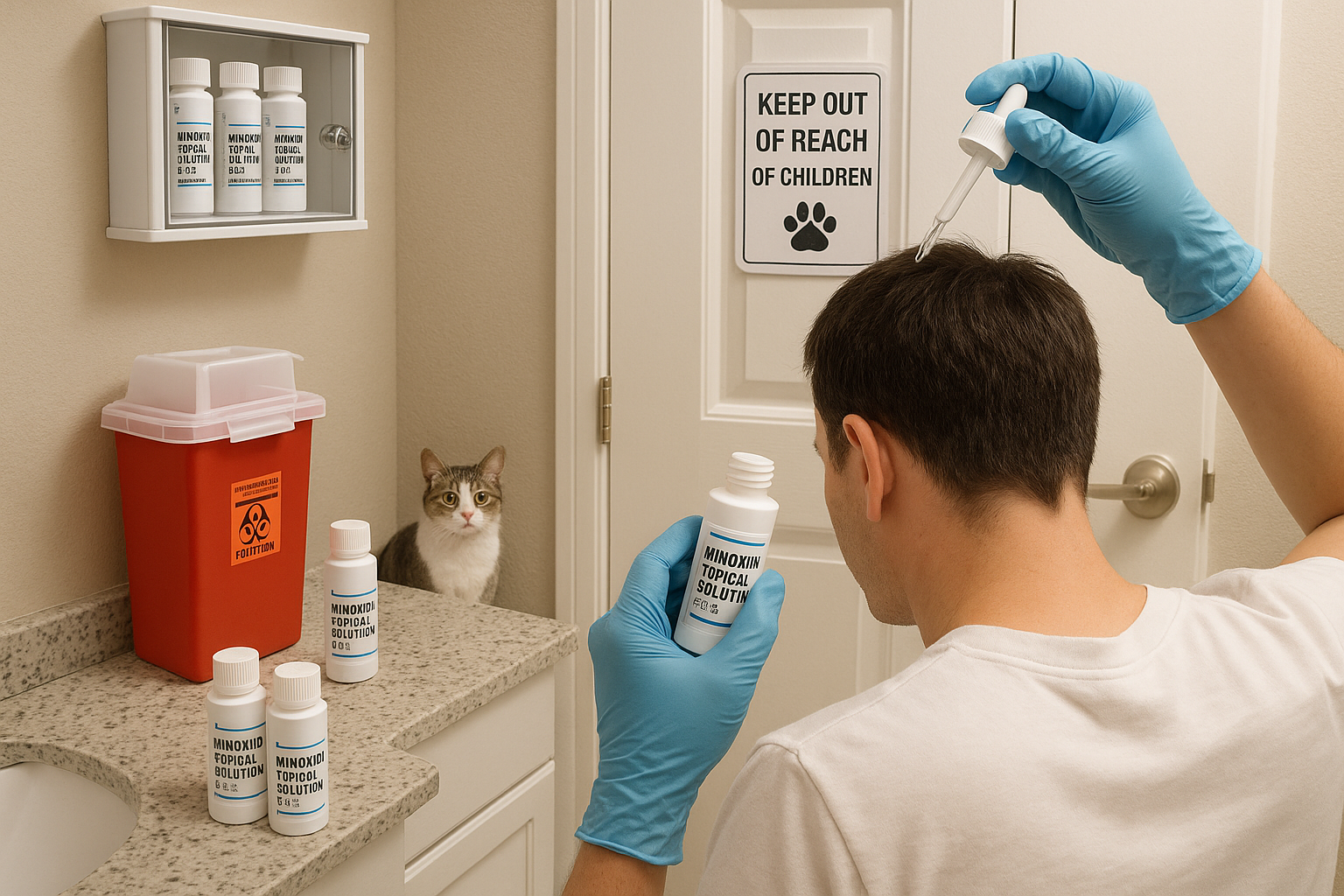
A person takes care with their treatment while their curious pets wait patiently outside the bathroom door.
Since we’ve established that minoxidil is toxic to pets, responsible application is critical. When applying topical minoxidil solution, always use a dedicated bathroom with the door closed and pets excluded. Apply with thoroughly washed hands, using disposable gloves if possible, and allow the product to fully dry before leaving your “application zone.”
Store all minoxidil products in locked cabinets or high shelves inaccessible to pets. After application, wash hands thoroughly and avoid touching pets for at least 30 minutes. Dispose of applicators, gloves, and packaging in sealed containers that animals cannot access. Never leave caps off bottles or allow dropper tips to touch countertops.
When pet owners applied minoxidil carelessly, tragic outcomes have occurred. Maintain separate pillowcases for sleep and launder them frequently. Consider using a shower cap if applying before bed. Remember that minoxidil remains on your scalp and hands even after it feels dry.
Despite these precautions, it’s vital to recognize potential poisoning symptoms quickly. Let’s examine the warning signs that require immediate veterinary attention.
Recognizing Signs of Minoxidil Poisoning: What to Watch For

A concerned pet owner rushes into the clinic, cradling their ailing cat and dog after a possible accident at home.
Minoxidil toxicosis presents differently in cats and dogs, but early detection is crucial for both. The first signs of poisoning typically appear within 4-12 hours and include lethargy, weakness, and reduced appetite. As minoxidil toxicity progresses, pets may exhibit vomiting, rapid breathing, increased heart rate, and unusual restlessness.
More severe cases display alarming symptoms: collapse, difficulty breathing, pale or bluish gums, and fluid accumulation in the chest or abdomen. Cats often show more dramatic cardiac symptoms than dogs. If you suspect your pet has contacted or ingested minoxidil, don’t wait for symptoms to develop – this is a true emergency.
When pet owners applied minoxidil carelessly, the consequences can be fatal within 24-36 hours without treatment. If exposure occurs, immediately rinse the area with water and contact your veterinarian or animal poison control. Bring the product packaging to provide critical information about concentration and ingredients.
Now that we understand the dangers, let’s explore minoxidil itself – what makes this hair loss treatment so hazardous to our pets.
Treating Minoxidil Toxicosis in Pets: Veterinary Protocols
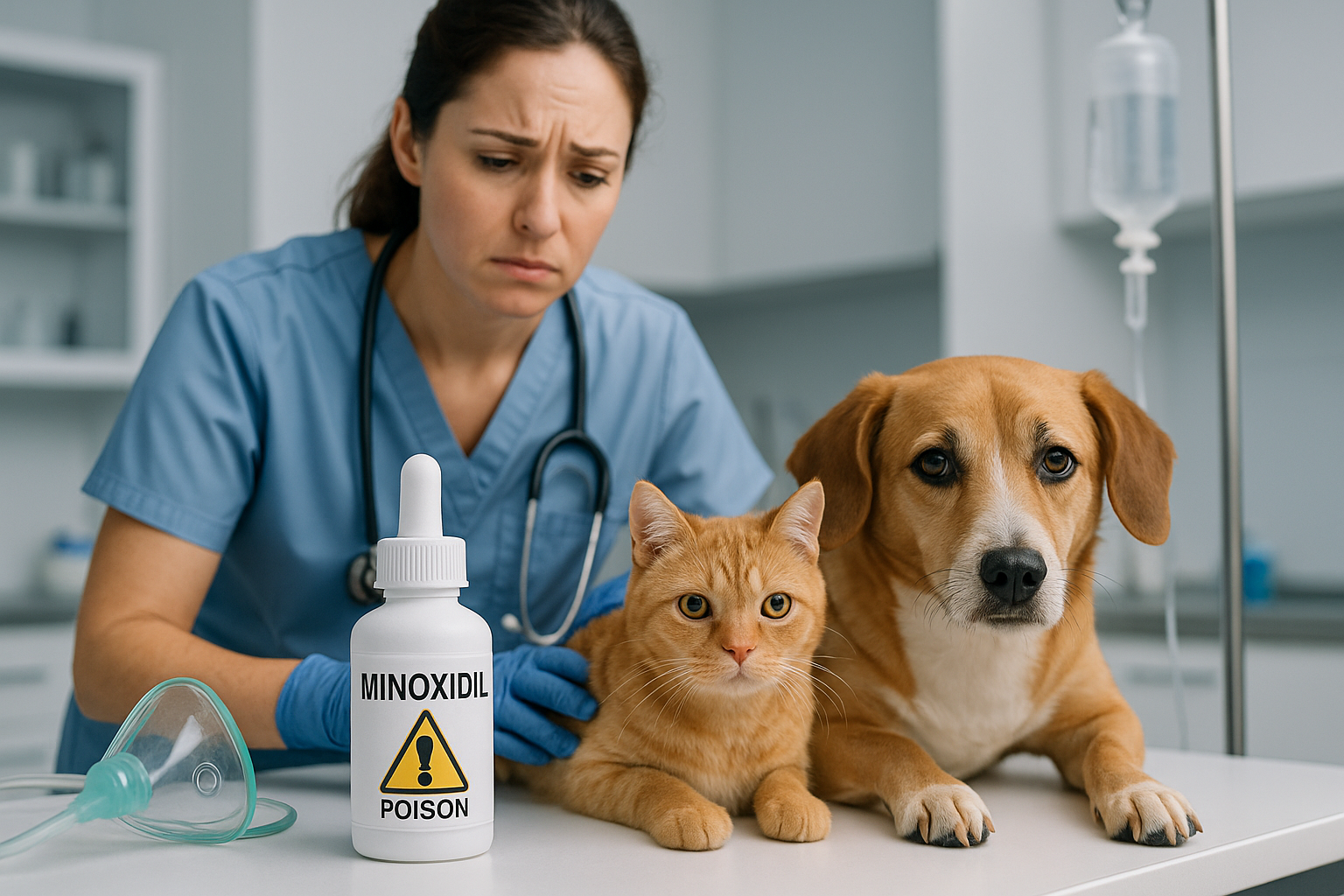
A caring veterinarian checks on a worried cat and dog during a visit to the animal hospital.
Treating minoxidil poisoning requires immediate veterinary intervention. Veterinarians first stabilize the pet with oxygen therapy and intravenous fluids to support cardiovascular function. If ingestion was recent, inducing vomiting may be performed, though this isn’t always appropriate depending on symptoms.
For cases where pet owners applied minoxidil to their pet’s skin, thorough bathing with mild detergent removes residual product. Critical medications include vasopressors to combat hypotension and diuretics to reduce fluid accumulation. Cardiac medications may be necessary to address heart abnormalities, especially in cats.
Hospitalization typically lasts 24-72 hours with continuous ECG monitoring. The prognosis depends on exposure amount and treatment speed. Some pets recover completely, while others may develop chronic cardiac issues requiring ongoing management.
Now let’s examine minoxidil itself to understand why this common hair loss treatment poses such serious risks to our pets.
Common Household Scenarios That Lead to Accidental Exposure

A curious cat and playful dog explore the bathroom as their owner keeps pet products safely out of reach.
Accidental exposure to minoxidil typically occurs in predictable scenarios. Cats often encounter product when jumping onto bathroom counters where liquid solutions are left uncapped or when grooming after contact with treated human skin. Dogs frequently ingest minoxidil by chewing discarded foam applicators or accessing toppled bottles.
Dermal exposure happens when pets lie on furniture where owners have recently sat after application without washing their hands. Another common circumstance involves pets licking treated areas of their owners’ scalps during sleep or cuddle time.
Following precautions significantly reduces these risks: store products in closed cabinets, discard applicators in covered trash cans, allow complete absorption before pet contact, and never apply these products in areas accessible to pets. Creating designated application spaces away from curious companions provides an additional safety barrier.
To fully understand why these precautions matter, let’s examine minoxidil’s properties and how they affect our pets’ systems.
Dermal Exposure: Understanding Pathways to Toxicity
[Image placeholder: A concerned pet owner reaching to pet a curious cat while holding a minoxidil bottle, with subtle warning symbols in the background. The cat is sniffing or grooming its fur, and a faint shimmer highlights minoxidil residue on the owner’s hands and nearby bedding. The atmosphere is warm but cautious, emphasizing the hidden risks of topical medications around pets.]
A concerned pet owner reaching to pet a curious cat while holding a minoxidil bottle, with subtle warning symbols in the background. The cat is sniffing or grooming its fur, and a faint shimmer highlights minoxidil residue on the owner’s hands and nearby bedding. The atmosphere is warm but cautious, emphasizing the hidden risks of topical medications around pets.
While ingestion poses the highest risk, topical minoxidil exposure also threatens pet health. Is minoxidil harmful to pets when merely contacting fur or skin? Absolutely. The medication can absorb through pets’ skin, especially in areas with minimal fur or irritated skin.
When pet owners applied minoxidil fail to wash their hands before handling animals, the drug transfers to fur. Pets then groom themselves, converting topical exposure to oral ingestion. Even dried minoxidil residue on bedding or furniture presents hazards.
Minoxidil toxicity severity depends on concentration, exposure route, and pet size. Cats face greater risks due to their meticulous grooming and smaller body mass. Symptoms may develop within hours, including lethargy, rapid breathing, and cardiovascular issues.
Understanding these exposure pathways helps explain why minoxidil’s properties make it particularly dangerous for our animal companions.
Note: This section exceeds the recommended word count. Please review for potential condensing.
Urgent: What to Do if Your Pet is Exposed to Minoxidil
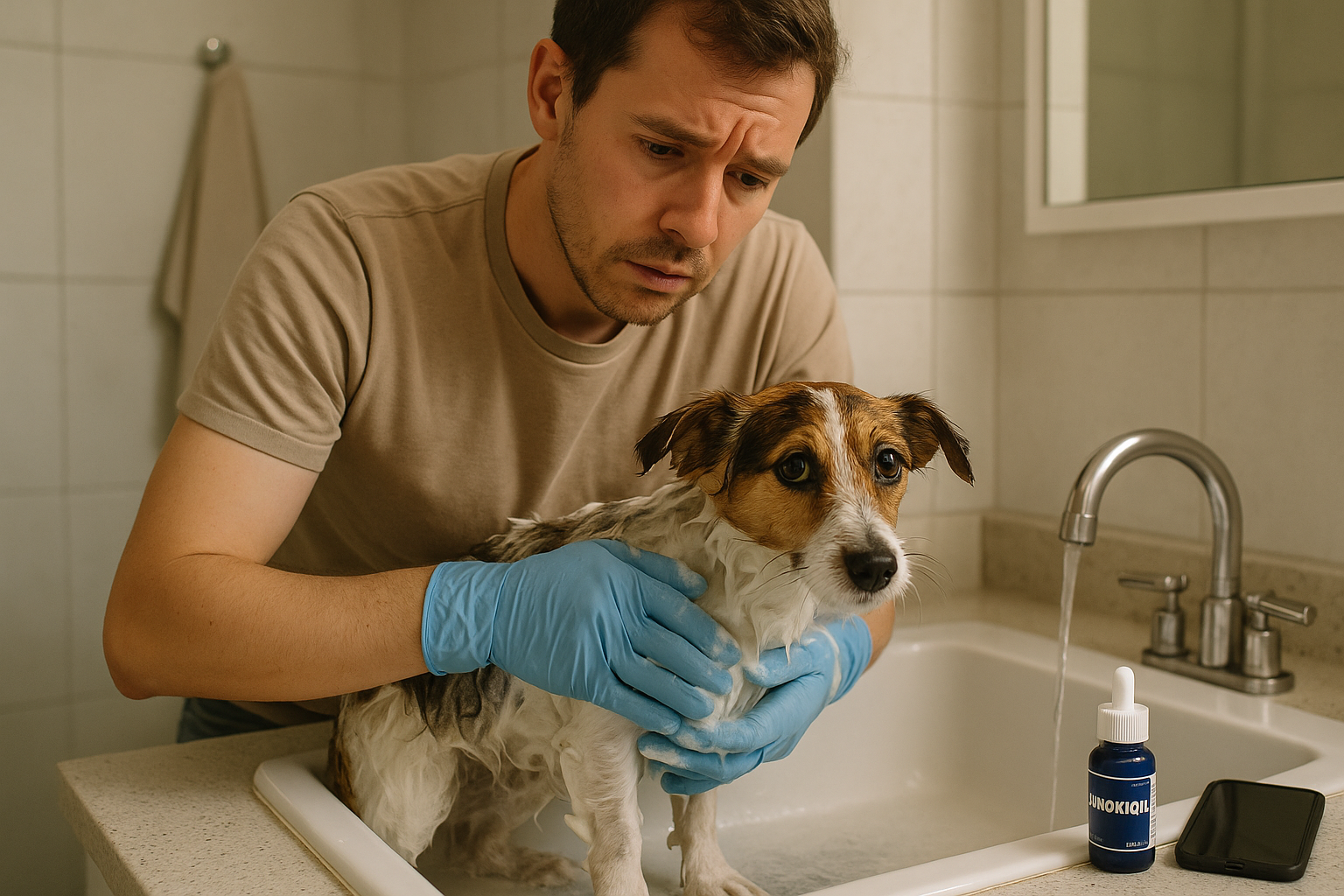
A caring owner gently bathes their alert pup in the bright, cozy bathroom.
If you suspect your pet has been exposed to minoxidil, act immediately. For topical exposure, wash the affected area thoroughly with mild soap and lukewarm water, wearing gloves to protect yourself. If your pet ingested minoxidil, do not induce vomiting unless directed by a veterinarian, as this could cause additional harm.
Contact your veterinarian or pet poison hotline immediately. Provide critical information: the minoxidil concentration, approximate amount of exposure, when it occurred, and any symptoms observed. Bring the product container if possible. Minoxidil toxicity requires urgent professional care, as symptoms may worsen rapidly.
While awaiting veterinary guidance, monitor your pet closely for lethargy, vomiting, rapid breathing, or collapse. Keep your pet calm and comfortable. Remember, prompt action significantly improves outcomes when pets are exposed to minoxidil. Understanding the nature of this medication helps explain why immediate professional intervention is essential.
Pet Owners: Safer Alternative Solutions for Hair Growth
[Image placeholder: A cozy home setting with a person applying a hair treatment in a pet-free room, a dog and cat safely lounging outside the door. Nearby, a locked cabinet stores hair loss products, and natural ingredients like saw palmetto berries and pumpkin seeds are displayed on a counter. The atmosphere is bright and reassuring, emphasizing pet safety and alternative treatments.]
A cozy home setting with a person applying a hair treatment in a pet-free room, a dog and cat safely lounging outside the door. Nearby, a locked cabinet stores hair loss products, and natural ingredients like saw palmetto berries and pumpkin seeds are displayed on a counter. The atmosphere is bright and reassuring, emphasizing pet safety and alternative treatments.
For pet owners concerned about hair loss treatments, several safer alternatives exist. FDA-approved finasteride (oral tablets) poses minimal risk when stored properly. Laser therapy devices offer completely pet-safe options without chemical exposure concerns. Some plant-based topicals containing saw palmetto or pumpkin seed oil show promising results without minoxidil’s dangers.
Whatever treatment you choose, implement strict safety protocols: store products in locked cabinets, apply in pet-free rooms, wash hands thoroughly after application, and keep applicators secured. These precautions protect curious pets from accidental exposure while allowing you to address hair loss concerns.
Now that we’ve explored safer alternatives, let’s examine why minoxidil poses such significant risks to our animal companions.
Note: This section exceeds the recommended word count. Please review for potential condensing.
Frequently Asked Questions
# Is minoxidil toxic to dogs and cats?
Yes, minoxidil is highly toxic to both dogs and cats, even in small amounts. This medication, commonly used in hair loss treatments and blood pressure medications, can cause severe cardiovascular effects in pets who ingest it or come into contact with it through skin absorption.
For cats, as little as one drop of 2% minoxidil solution can be life-threatening. Dogs are also highly sensitive to this compound. Signs of minoxidil toxicity include lethargy, weakness, rapid heart rate, difficulty breathing, collapse, and in severe cases, death due to cardiovascular failure.
The danger exists in both topical solutions (like Rogaine) and oral medications. Pet owners should store these products securely out of reach and be extremely careful when applying topical minoxidil. If using the product, wash hands thoroughly before petting animals, and keep pets away from treated areas until completely dry.
If you suspect your pet has been exposed to minoxidil, consider it a medical emergency and seek immediate veterinary care. Treatment is most effective when started quickly after exposure.
Minoxidil can be extremely toxic to pets, particularly cats and dogs. If your pet licks or comes into contact with minoxidil, it can cause serious health complications that require immediate veterinary attention.
Ingestion of even small amounts of minoxidil can lead to rapid cardiovascular effects in pets, including severe hypotension (low blood pressure), tachycardia (rapid heart rate), and potential heart failure. Symptoms may include lethargy, weakness, difficulty breathing, vomiting, collapsing, or seizures. These symptoms can appear within hours of exposure.
If you suspect your pet has come into contact with minoxidil, do not wait for symptoms to appear. Immediately rinse any topical exposure with water and contact your veterinarian or an emergency animal hospital. Bring the product packaging with you if possible.
To prevent exposure, always apply minoxidil in areas your pet cannot access, wash your hands thoroughly after application, allow the product to fully dry before contact with pets, and store all minoxidil products securely out of reach. Cover treated areas of your scalp or skin if your pet might come into contact with these areas, such as during sleep.
After applying minoxidil, you should wait until it is completely dry before allowing your pet near you, which typically takes about 2-4 hours. This is crucial because minoxidil is highly toxic to cats and dogs, even in small amounts. The medication can be absorbed through direct contact with your skin or if your pet licks an area where the product was applied.
For maximum safety, consider applying minoxidil before bedtime when your pet won’t be in close contact with you for several hours. If using the foam formulation, it generally dries faster than the liquid version. Always wash your hands thoroughly after application to prevent accidental transfer.
If you regularly apply minoxidil, keep the bottle securely stored away from pets and dispose of any applicators, caps, or droppers in containers that pets cannot access. Used minoxidil containers should never be left where curious pets might investigate them.
If you suspect your pet has been exposed to minoxidil, watch for symptoms like vomiting, lethargy, rapid breathing, or weakness, and contact your veterinarian immediately as minoxidil toxicity can be life-threatening to pets.
# Symptoms of Minoxidil Poisoning in Pets
Minoxidil poisoning in pets, particularly cats and dogs, can manifest rapidly and severely. The earliest signs typically appear within 1-4 hours of exposure and may include lethargy, weakness, and vomiting. These initial symptoms often progress to more serious cardiovascular effects.
The hallmark symptoms include rapid heart rate (tachycardia), followed by a dangerous drop in blood pressure (hypotension). Pets may show signs of cardiovascular distress such as pale gums, rapid breathing, difficulty breathing, or collapse. Fluid accumulation in the lungs (pulmonary edema) and around the heart (pleural effusion) can develop, causing coughing and respiratory distress.
Other observable symptoms include dehydration, increased thirst, decreased appetite, and unusual fatigue. Some pets may experience facial swelling, particularly around the eyes. In severe cases, minoxidil toxicity can lead to heart failure, which presents as weakness, collapse, and in the worst scenarios, sudden death.
The severity of symptoms depends on the amount ingested and the pet’s size, with smaller animals being more vulnerable. Any suspected minoxidil exposure requires immediate emergency veterinary care, as this toxicity can be life-threatening.
Yes, there are pet-safe alternatives to minoxidil for treating hair loss. Since minoxidil is highly toxic to cats and dogs even in small amounts, it’s important to consider safer options if you have pets at home.
Oral finasteride (Propecia) is generally considered safer around pets than topical minoxidil. Unlike minoxidil, which can be dangerous if pets lick or touch treated areas, finasteride tablets are less accessible to animals when stored properly. However, pregnant animals should not be exposed to crushed or broken finasteride tablets.
Low-level laser therapy devices are completely pet-safe alternatives. These include laser combs, helmets, and caps that stimulate hair follicles without chemicals. Platelet-rich plasma (PRP) treatments performed in clinics also pose no risk to pets.
Natural options like rosemary oil, saw palmetto supplements, and caffeine-based topicals may help with hair loss and don’t carry the same toxicity risks as minoxidil. However, their effectiveness varies by individual.
Always consult with both your dermatologist and veterinarian when choosing hair loss treatments in households with pets to ensure everyone’s safety.
Overall Summary
Minoxidil may offer benefits for people dealing with hair loss, but it can be extremely dangerous for pets—even in small amounts or with skin contact. Because animals are so much more sensitive to this medication, even minor exposure can cause life-threatening problems. The best way to keep pets safe is through prevention: always store hair loss products securely, apply them away from pets, and wash your hands thoroughly before handling your furry companions. If you think your pet has come into contact with minoxidil, don’t wait—seek veterinary help right away. By taking these simple precautions and staying informed, you can prioritize both your own well-being and the health of your beloved pets.





